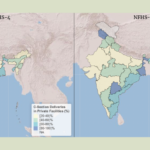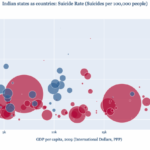Figure 1
Figure 2
The World Health Organization defines maternal mortality ratio (MMR) as the number of maternal deaths per 100,000 live births in a specific time period. In 2015, the WHO and partners released a statement that adopted a Sustainable Development Goal (SDG) of reducing MMR to 70 deaths per 100,000 live births by 2030. MMR is a reflection on the status of women in a country, their health and the country’s healthcare system. It is an important information that reveals gender disparity in a country. This is the reason, CEDA has chosen to focus on MMR in the first part of our Picture This series called, GenderStats.
The two pictures above reveal India’s progress and struggles with MMR over the years. The first picture on the left above shows us MMR and maternal mortality rate for India and various states as per the Sample Registration System (SRS) released by the Office of the Registrar General & Census Commissioner, India periodically. While maternal mortality ratio (MMR) is defined as the number of maternal deaths per 100,000 live births, maternal mortality rate is different and refers to the number of maternal deaths divided by the number of women of reproductive age (ages 15-49 in SRS). The second picture on the right helps us compare India’s MMR (as per World Bank) with other countries in the world between the years 2000 and 2017. Over time, India’s MMR has been steadily declining, which is a welcome trend, as it indicates in improvement in one aspect of women’s health.
According to SRS 2016-18 (latest round), India had an MMR of 113 and a maternal mortality rate of 7.3. Assam had the worst MMR in the country at 215 followed by Uttar Pradesh at 197. Kerala had the best MMR in the country at 43. Among south Indian states, Karnataka had the highest MMR at 92 while Andhra Pradesh, Telangana, and Tamil Nadu had an MMR of 65, 63, and 60. In north India, Punjab had a high MMR at 129 with Haryana following at 91. In SRS, data for Madhya Pradesh and Chhattisgarh, Bihar and Jharkhand, and Uttar Pradesh, and Uttarakhand was reported together till SRS 2014-16. SRS 2015-17 and 2016-18 shows a divergence in MMR between these states.
When we move the slider to the left on the timeline, we can see that India’s MMR has declined from 398 in 1997-98 (first round) to 301 in 2001-03 to 167 in 2011-13 and to 113 in 2016-18. At the same time, India’s maternal mortality rate has sharply declined from 34.8 in 1997-98 to 7.3 in 2016-18.
While India’s MMR has decreased significantly over the last three decades, how does it compare with other countries in the world? The graph on the right helps us answer this question. World Development Indicators from the World Bank show us MMR for India, Pakistan, United States, France, United Kingdom, China, Russian Federation, South Africa, Brazil, and Germany between the years 2000 and 2017. According to the World Bank, India had an MMR of 350 in the year 2000. In the same year Pakistan’s MMR was 286, China’s 59, Brazil’s 69, while Germany’s was only 7.
In the year 2017, India’s MMR had come down to 145, while Pakistan was at 140, China at 29, Russia at 17, United States at 19, United Kingdom, and Germany at 7. It is clear that while India has made significant improvement in MMR over the last three decades, there is still a huge gap when it comes to comparing India with other large economies and even India’s neighbourhood.
“GenderStats by CEDA” is a new series by the Centre for Economic Data and Analysis on the Picture This page. With the help of graphs, we will highlight the socio-economic and health status of Indian women and help understand their position vis-à-vis Indian men and other women in the rest of the world. If you have a suggestion for us or if there is an indicator that you would like us to focus on, please write to us at ceda@ashoka.edu.in
If you wish to republish this article or use an extract or chart, please read CEDA’s republishing guidelines.







